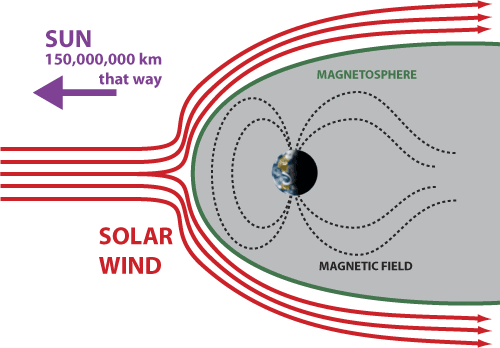The stakeout for northern lights in the Canadian tundra

- Launch: February 17, 2007
- Status: Active
The northern lights are a fascinating natural phenomenon. These animated shows in the night sky have contributed to the mythology, folklore, and art of many cultures and civilizations in the northern hemisphere. In the early 17th century, Italian astronomer Galileo named the phenomenon "aurora borealis" after the Roman goddess of morning, because he thought the luminescence was due to reflected sunlight in the atmosphere.

In the early 17th century, Galileo named this phenomenon "aurora borealis." (Credit: ©Jouni Joussila)

The solar wind has an average speed of 400 km per second, streaming around Earth like water around a rock. (Credit: Dr. Mikko Syrjäsuo)
We now know that the aurora are powered by the solar wind—an ever-present stream of ions and electrons that blows off the sun and expands outwards through space. This wind interacts with the Earth's magnetic field, distorting it and creating a downstream tail.
Solar wind energy is stored in this long tail and released unpredictably in bursts of accelerated particles and electron currents. Such bursts, called substorms, occur along the equatorial plane of Earth's night side, and then propagate along magnetic field lines to the polar regions, where they cause spectacular auroral displays.
But to this day, these auroral storms are not fully understood. Numerous studies of the Earth's magnetosphere and space weather have never been able to pinpoint where in the magnetosphere the energy of the solar wind transforms explosively into auroras.
Tripping the light fantastic
NASA launched a constellation of five small satellites on 17 February 2007, all carrying identical suites of electric, magnetic, and particle detectors to study aurora. These satellites fly in carefully coordinated orbits. Every four days, they line up along the Earth's magnetic tail to track disturbances in the magnetosphere.
Satellite data from the THEMIS mission (for "time history of events and macroscale interactions during substorms") are compared to observations from ground stations across the Arctic Circle. In North America, 20 observatories equipped with automated, all-sky cameras take pictures every three seconds over the two-year mission, for a total of 140 million pictures.

The satellites have formed a constellation after separating from their launch rocket. (Credit: Berkeley University)
Universal implications
Aside from the spectacular light shows they produce, substorms are of great scientific interest. The processes that are thought to be at work in them are also thought to occur in the solar corona and other more distant and exotic objects in the cosmos. The substorm provides us with the only place in nature where we can directly study these interesting phenomena. THEMIS will advance our understanding of the universe.
THEMIS is a NASA-funded mission led by researchers at the University of California at Berkeley and involves scientists from the U.S., Canada, and Europe. Current Canadian activity is funded by the Canadian Space Agency. Ultimately, THEMIS will involve scientists from the Universities of Calgary, Alberta, New Brunswick, and Saskatchewan, as well as the Natural Resources Canada Geomagnetic Laboratory.